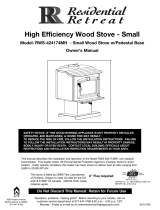
GHP Group warrants that your new woodburning stove or
masonry wood insert is free from manufacturing and material
defects for a period of five years from the date of sale, subject
t
o the following conditions and limitations.
1. This warranty is extended to the original owner only, for
residential use, and is subject to proof of purchase.
2. The new GHP Group product must be installed and operated
at all times in accordance with the installation and operation
instructions supplied with the appliance, and installation must
be to local and national codes. Any alterations, willful abuse,
accident, over firing or misuse will not be coverd under warran-
ty. NOTE: Some minor movement of certain parts is normal
and is not a defect and therefore, not covered under warranty.
3. The warranty is non-transferable, and is made to the original
owner, provided that the purchase was made through an
authorized GHP Group supplier. The serial number must be
supplied along with the Bill of Sale, showing the date of
purchase, at the time the claim is submitted.
4. This warranty is limited to the repair or replacement of parts
only, found to be defective in material or construction, provided
that such parts have been subjected to normal conditions of
use and service, after a said defect has been confirmed by
GHP Group, or an authorized representative’s inspection.
Defective parts must be shipped back (at GHP Group discre-
tion), transportation prepaid, to the manufacturer. Credits will
be issued upon receipt of return of the defective product to
GHP Group.
5. GHP Group, at its discretion, can fully discharge all obligation
with respect to this warranty by refunding the wholesale price
of the defective part(s).
6. Any installation, labor, construction, transportation or other
related costs or expenses arising from defective parts, repair,
replacement or otherwise of same, will not be covered by this
warranty nor will GHP Group assume responsibility for same.
Further, GHP Group will not be responsible for any incidental,
indirect or consequent damages, except as provided by law,
and in no event shall they exceed the original purchase price.
7. All other warranties - expressed or implied - with respect to
the product, its components and accessories, or any obliga-
tions/liabilities on the part of GHP Group are hereby expressly
excluded.
8. GHP Group neither assumes, nor authorizes any third party
to assume, on GHP Group’s behalf, any other liabilities with
respect to the sale of this GHP Group product.
9. The warranties as outlined within this document do not apply
to chimney components or other products made by other
manufacturers when used in conjunction with the installation
of this product. Improper use or the use of non-approved
components may nullify your warranty. If in doubt, contact
your nearest GHP Group supplier or GHP Group Customer
Service Department.
10. GHP Group will not be responsible for:
• Downdrafts or spillage caused by environmental conditions
such as nearby trees, buildings, rooftops, hills, mountains, or
ineffective chimney design.
• Inadequate ventilation, excessive offsets or negative air
pressure caused by mechanical systems such as furnaces,
clothes dryers, fans, etc.
11. This warranty is void if:
• The appliance has been operated in atmospheres contaminated
by chlorine, fluorine, or other damaging chemicals.
• This appliance has been subjected to prolonged periods of
dampness or condensation.
• The appliance has any damage due to water, or weather
damage that is the result of, but not limited to, improper
chimney/venting installation.
• The appliance has been subjected to willfull or accidental
abuse or misuse.
• Corrosive driftwood, manufactured logs or other fuels are
used other than as outlined in the installation and operating
instructions.
• The appliance is not maintained in good condition, including
firebrick and gaskets.
Doors with Glass and Plated Parts
G
lass is warranted against thermal breakage only. To clean glass,
use a ceramic/glass cleaner or polish. Do not use ammonia
based cleaners. A suitable cleaner is available at your nearest
Pleasant Hearth dealer. DO NOT CLEAN GLASS WHILE HOT
AND DO NOT USE ABRASIVE CLEANERS.
Plated parts will not be covered under this warranty. Plated
parts should be cleaned by using denatured alcohol only and
rubbed lightly with a lint-free non-abrasive cloth. Excessive
rubbing or polishing may remove the plated finish. Plated parts
may also be damaged by external chemicals.
Further Exclusions
This warranty will not include or extend to paint, gaskets or fire-
brick components, and does not cover any removable firebox
components such as brick retainers or stainless steel air tubes.
Electrical Components
GHP Group warranty coverage extends to electrical components
(e.g. blowers, speed controls) also.
IF WARRANTY SERVICE IS REQUIRED
Contact GHP Group Customer Service. Make sure you have
your sales receipt and the model/serial number of your GHP
Group product.
Do not attempt to do any service work yourself, unless pre-
approved by GHP Group in writing as this will void the warranty.
GHP Group must authorize service and provide a Warranty
Claim Number prior to any warranty related service calls.
Without an authorization number, any service work will not be
deemed warranty.
IMPORTANT NOTICE
BEFORE LIGHTING YOUR FIRST FIRE, REMOVE PLASTIC
FILM OFF TRIM AND CLEAN THE PLATED SURFACES WITH
DENATURED ALCOHOL OR A GOOD QUALITY, NON-ABRASIVE
LIQUID GLASS CLEANER. APPLY WITH A VERY SOFT,
CLEAN CLOTH. DO NOT USE PAPER TOWELS TO CLEAN
THE PLATED PARTS. FAILURE TO CLEAN ALL MARKS AND
FINGERPRINTS FROM THE PLATED SURFACES WILL
CAUSE PERMANENT DAMAGE.
NOTE: Some states and provinces do not allow the exclusion or
limitation of incidental or consequential damages. The above
limitations may not apply to you.
GHP Group, Inc. • 8280 Austin Ave. • Morton Grove, IL 60053
KEEP THIS WARRANTY
Serial #_______________________________
Model #________________________
Date Purchased________________________
17
60-10-001
5 Year Warranty





















